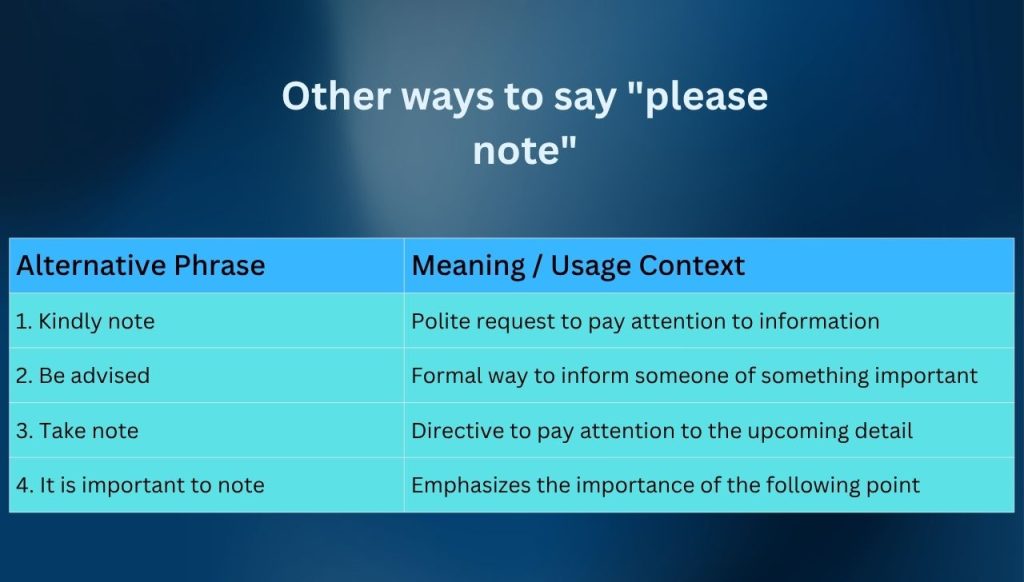Let’s be honest—how often have you typed “please note” without thinking about it? It’s a go-to phrase in emails, reports, and professional communication. But after a while, it starts sounding stiff or overly formal, right? Whether you’re writing to a colleague, client, or customer, switching things up can make your message more engaging and human. That’s why having a few alternatives up your sleeve is not just helpful—it’s necessary.
What Does “Please Note” Mean?
At its core, “please note” is a polite way of asking someone to pay attention to a particular detail. It flags information the reader might otherwise overlook. Think of it as a gentle tap on the shoulder: “Hey, this part matters.”
In formal writing, it’s often used to draw attention to policies, deadlines, exceptions, or anything you want your reader to remember. It carries a tone of courtesy while emphasizing importance.
When Should You Use “Please Note”?
The phrase comes in handy when you need to:
- Highlight a change (e.g., a new policy or updated schedule)
- Emphasize a requirement (e.g., documents to bring, steps to follow)
- Clarify expectations (e.g., project timelines, attendance rules)
- Signal an exception (e.g., special case or conditional rule)
In short, whenever the stakes are even mildly high or miscommunication would be problematic, that’s when “please note” or one of its alternatives fits.
Why Bother Saying It Differently?
Tone matters—a lot. “Please note” is perfectly fine, but repeating the exact phrase repeatedly can make your writing feel robotic. Switching up your language keeps things fresh, adds personality, and allows you to match tone with context (formal, friendly, urgent, etc.).
Also, varying your phrasing can:
- Prevent reader fatigue
- Match branding voice
- Improve clarity and relatability
- Enhance reader engagement

Other ways to say “please note”
| Alternative Phrase | Meaning / Usage Context |
|---|---|
| 1. Kindly note | Polite request to pay attention to information |
| 2. Be advised | Formal way to inform someone of something important |
| 3. Take note | Directive to pay attention to the upcoming detail |
| 4. It is important to note | Emphasizes the importance of the following point |
| 5. Please be aware | Alerting someone to a relevant fact or change |
| 6. Let it be known | Slightly formal; used to announce something of importance |
| 7. You should know that | Informal; introduces something the reader/listener ought to be aware of |
| 8. Just a reminder | Polite prompt about existing or previously shared information |
| 9. We would like to inform you | Formal introduction to new or important information |
| 10. Attention: | Direct and sometimes urgent call for focus |
| 11. For your information | Casual or formal; gives helpful or necessary information |
| 12. Heads-up | Informal warning or preview of something coming up |
| 13. Keep in mind | Suggests the information should be remembered for context or future action |
| 14. Important: | Highlights key information |
| 15. As a reminder | Reinforces previously mentioned details |
| 16. Be informed that | Very formal way of stating new or essential information |
| 17. Please be reminded | Polite formal reminder of a rule, deadline, or fact |
| 18. This is to inform you | Used in formal announcements |
| 19. Do note | Slightly formal alternative to “please note” |
| 20. Bear in mind | Encourages thoughtful consideration of a point |
| 21. Allow us to point out | Polite and formal introduction to a noteworthy issue |
| 22. Kindly be informed | Formal, respectful tone to deliver information |
| 23. Make sure to note | More directive, implies the info may require action |
| 24. Keep this in mind | Emphasizes the importance of remembering a point |
| 25. Be sure to note | Suggests attention to something important or easily overlooked |
| 26. It should be noted that | Neutral, often used in reports or formal writing |
| 27. We draw your attention to | Formal and slightly legal phrasing to emphasize an important matter |
| 28. Please take into account | Encourages consideration of the information in decision-making |
| 29. Please observe | Often used for rules, regulations, or behavioral expectations |
| 30. You are reminded that | Used to reinforce policies or deadlines |
Conclusion
So there you have it—30 different ways to say “please note” that won’t disturb your readers. From the casual to the more polished, these alternatives allow you to match your tone and context without losing clarity. Language doesn’t have to be boring, even in the workplace. A few tweaks here and there can make your message land smoother—and maybe even get noticed faster.

Emma is a linguist and ESL instructor with over a decade of experience helping students master English grammar. Passionate about clarity and simplicity, she writes lessons that make even tricky topics feel approachable.


